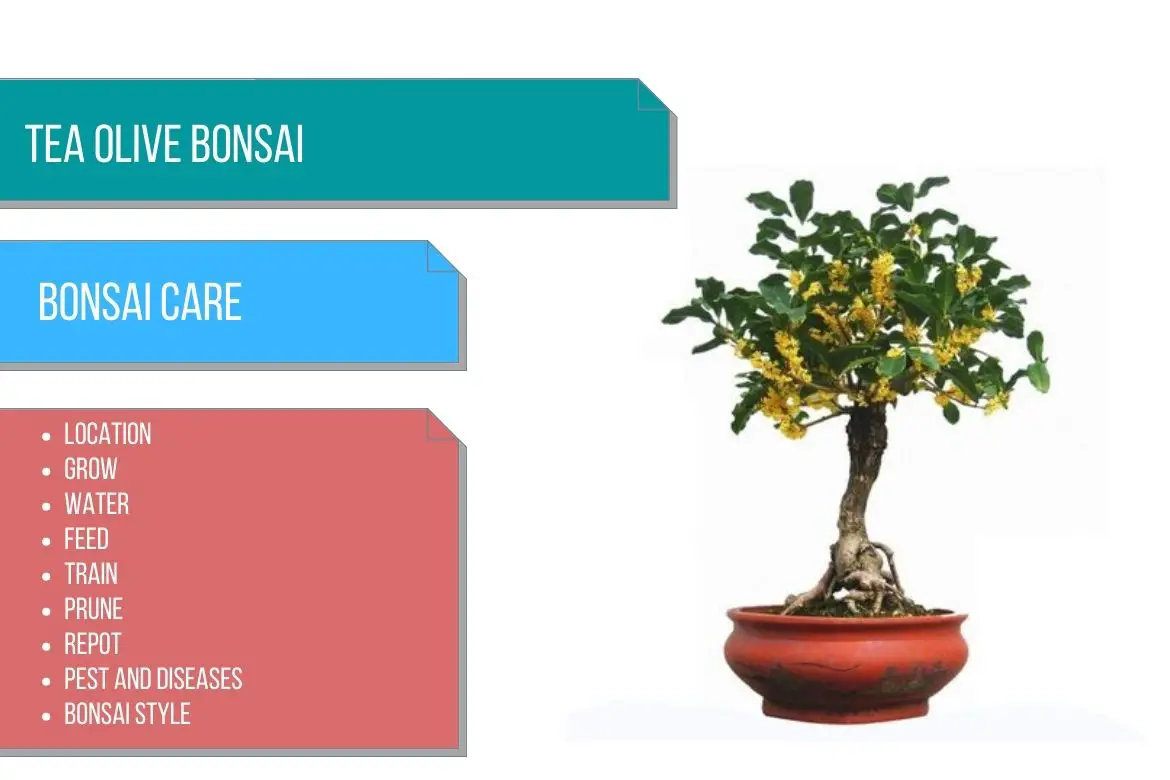
Tea Olive
(Osmanthus fragrans)
Country of Origin : China and Japan
Bonsai Styles : Informal upright, multi-trunk
Zone : 8 – 10
The term fragrans means ‘fragrant’. The tea olive has a cluster of small flowers that are extremely fragrant, as its botanical name suggests.
The leaves of the tree are dark green in color and oval in shape. The leaves are similar to holly plant leaves, hence this plant is also called ‘false holly‘. Another name it is known by is ‘sweet olive‘. Because of the sweet smell its flowers emit.
The mostly smooth bark has an attractive gray color.
The tree also produces flowers which range from white to yellow in color all throughout the months of fall to spring.
These fragrant flowers along with the backdrop of gray bark and green foliage make for a very attractive bonsai tree.
Tea olive bonsai tree is also a very good indoor bonsai.

The fragrant tiny flowers (about 1 cm in diameter) are borne in clusters.
Best location to keep Tea Olive Bonsai
Tea olive bonsai tree prefers a bright sunny location. It can be placed outside in the sun in summer.
It is recommended that the bonsai tree be kept at a temperature of 70°F to 85°F (21°C to 30°C) in spring and summer for optimal growth.
A temperature range of 60°F to 65°F (15°C to 18°C) is recommended in winter.
It is a good bonsai as an indoor bonsai as well. When keeping it indoors, keep the pot in a south or west facing window.
IMP: Refer sunlight requirements for indoor plants for more indoor gardening ideas. Also, refer to do bonsai trees need sunlight for more indoor and outdoor bonsai location ideas.
Propagation of Tea Olive
Tea olive can be propagated through stem cuttings.
Take stem cuttings (6-8 inches) in early winter. Remove the leaves from the bottom half of the stem. Apply some rooting hormone to the stem and plant it in a container with moist soil.
The roots will emerge on the stem by early spring.
Watering Tea Olive Bonsai
Tea olive tree is drought tolerant. But keep the bonsai soil barely moist at all the times.
In hot summers, you might find yourself watering the tree a bit more frequently.
The tree thrives in high humidity. You can spray some mist on the foliage.
Read watering bonsai tree for more details.
Wiring Tea Olive Bonsai
The branches of tea olive remain flexible, so the wiring can be performed at any time during the life of the plant.
Pruning Tea Olive Bonsai
When to prune Tea Olive bonsai?
How to prune Tea Olive bonsai?
The new growth of the tree should be pruned back to two sets of leaves while you are developing the shape of the bonsai tree.
As a result of performing this action, you will also remove the buds of the fragrant flowers as you go along.
It is recommended to prune mature bonsai tea olive in early summer since it flowers from fall to spring on the tips of hardened growth that has matured.
In areas with strong growth, prune it back to two leaves, while in areas with weaker growth, cut it back to four leaves.
When pruning, it is always important to prune back to healthy leaves that have dormant buds visible at the base of the leaf.
Branches should be left to grow freely after this pruning in order to flower.
The plant will grow very little during flowering, so no pruning will be required.
Immediately after flowering, a very light pruning can be done (if needed), then wait until the next summer to prune again.
Repotting Tea Olive Bonsai
When to repot Tea Olive bonsai?
Tea olive bonsai can be repotted every 3-4 years.
You can use a basic free-draining bonsai soil mix as a potting soil.
Must Read: Bonsai Soil Recipes
Must read : Choosing the right bonsai container
Feeding Tea Olive Bonsai
The bonsai should be fertilized weekly with a well-balanced fertilizer at half strength while in active growth.
The feed should be applied every two to three weeks in the fall and winter if the temperature is above 55°F (12°C).
The tea olive prefers slightly acidic soil, so once a month during active growth apply a half strength acidic fertilizer formulated for azaleas or camellias.
Read more about bonsai fertilizer and its application.
Diseases and pest of Tea Olive Bonsai
A tea olive bonsai tree is almost pest-free. Diseases and insects can occur occasionally, especially when the plant is under stress.
In drought stressed plants, Botryosphaeria canker is the most commonly found pest.
There are occasional problems with Cercospora leaf spot and anthracnose.
Poorly drained or excessively wet soil can cause root rots.
One of the most common insect pests are scales. 5 tablespoons of 2% horticultural oil mixed with one gallon of water can be applied to control the insects.
Tea Olive bonsai care
In cool regions, the older leaves of the Tea Olive bonsai are often marked by tiny holes or brown-black spots during the winter months.
Don’t get panicked by this. This is not a disease or due to pests.
This is just normal. As soon as spring arrives, newer leaves will replace these older leaves with holes.
In case your region falls outside the mentioned hardiness zones (8 – 10), move the bonsai tree indoors as soon as winter arrives.
Make sure that your tea olive bonsai receives enough sunlight. or else it will not bloom as it is suppose to.

